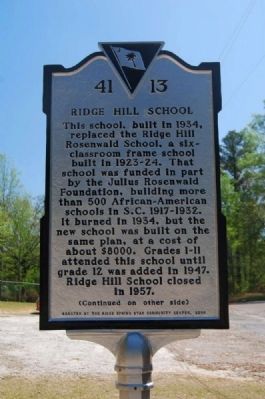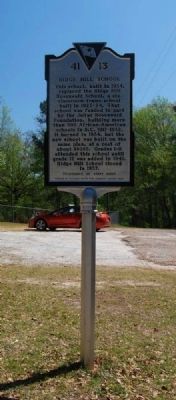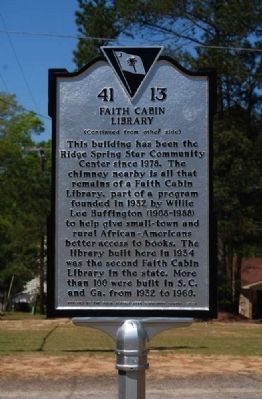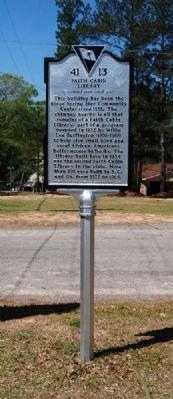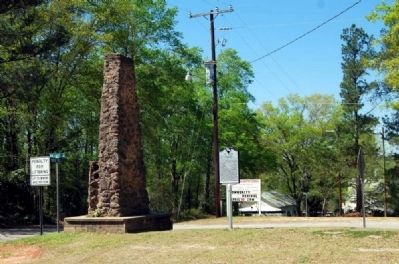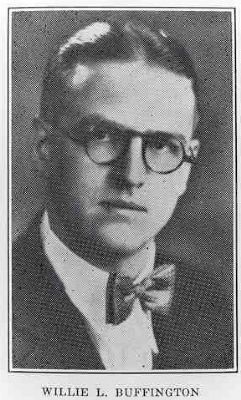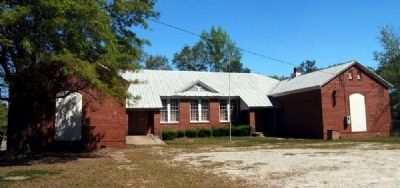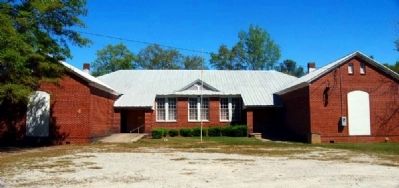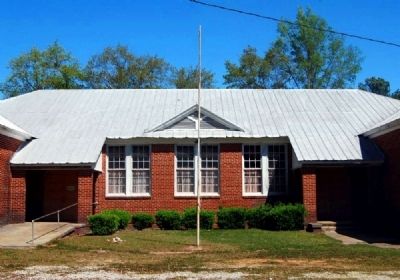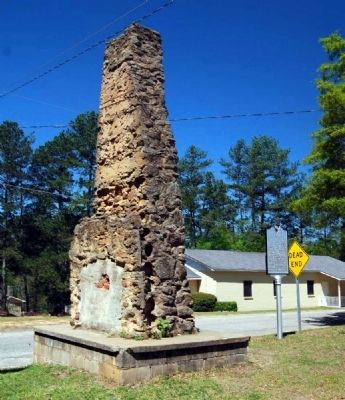Ridge Spring in Saluda County, South Carolina — The American South (South Atlantic)
Ridge Hill School / Faith Cabin Library
Erected 2009 by Ridge Spring Star Community Center. (Marker Number 41-13.)
Topics and series. This historical marker is listed in these topic lists: African Americans • Education. In addition, it is included in the Rosenwald Schools series list. A significant historical year for this entry is 1934.
Location. 33° 51.167′ N, 81° 39.55′ W. Marker is in Ridge Spring, South Carolina, in Saluda County. Marker is at the intersection of Ridge Hill Drive and Williams Avenue, on the left when traveling east on Ridge Hill Drive. Touch for map. Marker is in this post office area: Ridge Spring SC 29129, United States of America. Touch for directions.
Other nearby markers. At least 10 other markers are within 8 miles of this marker, measured as the crow flies. Michael Watson (approx. half a mile away); Ridge Spring (approx. 0.6 miles away); Ridge Spring Cemetery / W.H. Scarborough (approx. 0.9 miles away); Alexander Hamilton Stevens (approx. 0.9 miles away); Jones Cemetery / General James Jones (approx. 1.1 miles away); Jacob Odom House (approx. 2.4 miles away); Spann Methodist Church / Captain Clinton Ward (approx. 4 miles away); Batesburg Institute (approx. 7.2 miles away); Blinding of Isaac Woodard (approx. 7.3 miles away); Lott's Tavern & Post Office (approx. 7.4 miles away). Touch for a list and map of all markers in Ridge Spring.
Also see . . .
1. Rosenwalf Fund. The Rosenwald Fund (also known as the Rosenwald Foundation, the Julius Rosenwald Fund, and the Julius Rosenwald Foundation) was established in 1917 by Julius Rosenwald and his family for "the well-being of mankind." (Submitted on April 8, 2011, by Brian Scott of Anderson, South Carolina.)
2. Faith Cabin Libraries. Voluntary groups formed to provide Blacks with access to reading materials in response to the near total neglect by officials in county and state government. (Submitted on April 8, 2011, by Brian Scott of Anderson, South Carolina.)
3. FAQ: What are Faith Cabin Libraries. During the Depression, the segregated South denied African-Americans access to county libraries and the reading materials they contained. (Submitted on April 8, 2011, by Brian Scott of Anderson, South Carolina.)
Additional commentary.
1. Willie L. Buffington
By John Monk
The State
April 4, 2005
White man struggled to bring books to poor blacks: He’s not in the history books. But he ought to be. Using donated books, mill worker opened libraries in rural areas during segregation.
Willie Lee Buffington, a poor white millworker from Saluda, started out with a dime and a prayer. And he worked a miracle that touched thousands.
His miracle was this: in the 1930s, 1940s and 1950s, Buffington helped equip more than 100 libraries for black people in poor communities in rural South Carolina and Georgia.
By getting people across America to donate some 200,000 books over 30 years, he created a unique chain of backwoods libraries for people who had little or nothing to read. They were called the Faith Cabin Libraries — faith because they were built on faith, cabins, because many were built out of logs.
“He’s a phenomenon,” said Dan Lee, a Lander University librarian who “discovered” Buffington while a student at the University of South Carolina in the 1980s. Lee wrote some papers on Buffington. But outside academic circles, Buffington — who died virtually unnoticed in 1988 in Saluda — has been unknown in modern times.
Now, however, a new trove of material on Buffington will soon be available to the public at the University of South Carolina Caroliniana Library, a major depository for state history.
Archivists are processing papers given by Bobby Buffington, Buffington’s 45-year-old grandson, a Columbia lawyer. His gift included thousands of documents of Faith Cabin papers.
Willie Lee Buffington’s story is not just a story of learning. It’s a story of how love can transform. A kindly black school teacher, Euriah Simpkins, encouraged Buffington as a child to read and go to college. Buffington responded by dedicating part of his life building libraries for impoverished blacks.
Historians agree it took courage to do what Buffington did. It was a time when most South Carolina whites believed blacks were not worth educating, when the Ku Klux Klan was a state power, when laws kept blacks out of libraries and when lynching blacks was widely accepted.
Buffington’s daughter, Ethel Brown, 70, of Saluda, said her father sometimes was threatened by whites. One white acquaintance said he’d rather have his son in the penitentiary than working with blacks as Buffington did, said Brown.
She is still amazed at what her father...a book-lover who used to go to sleep reading a book...managed to do.
“You think of philanthropists doing something like this. But my dad grew up in a poor rural family. If he’d had lots of money, you’d expect this. But all he had was a dream,” said Brown.
“He really didn’t have a whole lot more than the people he was trying to help.”
Enter an Angel
Willie Lee Buffington was born in 1908 in Saluda, the son of a poor farmer. In his youth, the family often went without meat or sugar.
His grandmother often read the Bible to him, saying, “Trust in God and He will help you.”
When Buffington was nine, he was making mud pies by the side of the road. When one wouldn’t hold together, he began to cry.
Simpkins, a black school teacher was passing by and gently told him to “be a man.” Simpkins and young Buffington became lifelong friends. Simpkins gave the white boy books to read and encouraged him to go to college and become a minister.
In 1931, while working as a mill worker in Edgefield, Buffington attended the dedication of Simpkins’ new black school in Saluda. It had been built with money from a Northern philanthropist.
Buffington was shocked. The school had no books. “It was unthinkable that a school should not have a few books,” he later wrote.
Returning home, he had an inspiration. He picked the names of five ministers out of a Sunday School publication and wrote them letters asking for a book. He used his last dime at the time (stamps were two cents each) to post the letters.
“The Negroes have no books,” he wrote. “Good books will help them more than anything else. I’m going to start a library for them. Could you send me a book for it, or if you have none to send, then please give me a stamp so I can write to somebody else.”
He never heard from four of the ministers. But two months later, he got a letter from the Rev. L. H. King of St. Mark’s Methodist Church in New York, in the heart of Harlem. King sent 1,000 books that his congregation had gathered.
Finding themselves with more books than the new school could handle, Buffington and Simpkins called a community meeting to see if local blacks wanted to build a library. The answer was yes.
In a matter of months, with blacks providing the labor, and black and white donors providing trees, they built a library near Saluda. It was 18 feet by 22 feet and had a rock chimney. People used barrels for chairs and read by the light of kerosene lamps. The closest electric power was five miles away.
A black woman suggested they name it “Faith Cabin Library” because when they began, they had nothing to go on but faith.
A small magazine wrote a story about the Faith Cabin. Its readers sent enough books to start another library in Ridge Spring, about 10 miles south of Saluda. Over the next 20 years, religious magazines and even mainstream publications such as Reader’s Digest wrote about the Faith Cabin Libraries. The State newspaper, so far as is known, reported on Buffington only once.
On May 1, 1933, five months after the first Faith Cabin was built, The State published a story on its editorial page about a “young white man” who was showing “goodwill towards his Negro neighbors.” The State said approvingly, “Inter-racial relations would improve far faster in South Carolina if there were more Willie Lee Buffingtons.”
The publicity helped. Each time an article appeared, people sent Buffington more books.
Undaunted by the flood of books, Buffington took on the unofficial mission of creating more libraries, continuing into the 1960s.
“His vision expanded,” said librarian Lee.
Dozens of groups across the country supported his libraries. They included Dartmouth College students in New Hampshire, a Kiwanis Club in California and an interfaith group in Iowa City.
Out on a Limb
Buffington was a rebel against his era’s entrenched racial attitudes.
“It was just considered something you didn’t do,” said University of South Carolina historian and S.C. native Dan Carter. Many whites believed that educating blacks “would spoil a good field hand,” said Carter.
In 1930, the year before Buffington began his campaign, U.S. Sen. Cole Blease, D-S.C., ran his re-election campaign partially on the platform of lynching blacks. In July 1930, the Charleston News & Courier ran a front-page editorial saying that if Blease were elected, it would be an endorsement of lynching. Blease lost — but only barely to a newcomer named Jimmy Byrnes.
In 1932, South Carolina’s most prominent white journalist, W.W. Ball, wrote a book about South Carolina, The State That Forgot.
In it, Ball noted that in South Carolina in the 1930 census, whites outnumbered blacks. But, Ball wrote, “We still have too many Negroes. ... the state needs more white people.”
In 1933, Strom Thurmond, D-S.C., then in his first years as a state senator, introduced a bill to prohibit blacks from working in even menial jobs in state office buildings.
Bob Williams, retired professor of libraries and information science at the University of South Carolina, said Buffington is a “forgotten hero” for reaching out to book-starved, underprivileged African-Americans in that era.
In the 1930s, most rural S.C. counties had no libraries for either blacks or whites. Only two public library systems — in Columbia and Charleston — offered any services at all for blacks.
“It was a tremendously worthwhile thing for him to do. It filled a tremendous gap,” said Williams.
Educating Himself
As he brought books to poor black communities, Buffington transformed himself.
It wasn’t until after he created the first library that he graduated from Edgefield High School, at the same time raising a family and working in a textile mill.
Eventually, he put himself through Furman College (class of 1938), becoming the first person in his family to get a college degree. He entered seminary, becoming a Methodist minister.
All the while, he worked part-time jobs to support his family. For two years in the 1940s, he taught at Columbia’s Benedict College. Then he taught at Paine College in Augusta, also an historically black college, where he stayed until his retirement in the 1970s.
Throughout this time, Buffington kept establishing libraries — about 30 in South Carolina and 70 in Georgia — and getting new books for existing libraries. His mentor Simpkins had died in the 1940s.
In the 1960s, Congress passed civil rights laws, forcing South Carolina whites to open public libraries to blacks. The state had slowly begun establishing second-rate branch libraries for blacks during the 1950s.
In the 1970s, the Faith Cabin Libraries went out of business. They were no longer needed. Today, few traces of them remain.
Why Help?
In his day, Buffington was asked why he decided to dedicate his life to helping blacks.
First, there was the childhood experience of being exposed to a caring mentor, Simpkins.
Second, Buffington once wrote, he had been walking the streets of Edgefield ...then a staunchly segregationist town...when a black child saw him and ran screaming with fright. The idea that just being white could scare a black made him want to help blacks, he said.
Finally, as a youth, he heard a preacher named John Lake give a sermon about going all the way to China to help the underprivileged.
“I then resolved that if John Lake could go to China, I could serve at home,” he said.
— Submitted April 8, 2011, by Brian Scott of Anderson, South Carolina.
Credits. This page was last revised on June 16, 2016. It was originally submitted on April 8, 2011, by Brian Scott of Anderson, South Carolina. This page has been viewed 1,069 times since then and 31 times this year. Photos: 1, 2, 3, 4, 5. submitted on April 8, 2011, by Brian Scott of Anderson, South Carolina. 6. submitted on December 25, 2010, by Brian Scott of Anderson, South Carolina. 7, 8, 9, 10. submitted on April 8, 2011, by Brian Scott of Anderson, South Carolina.
